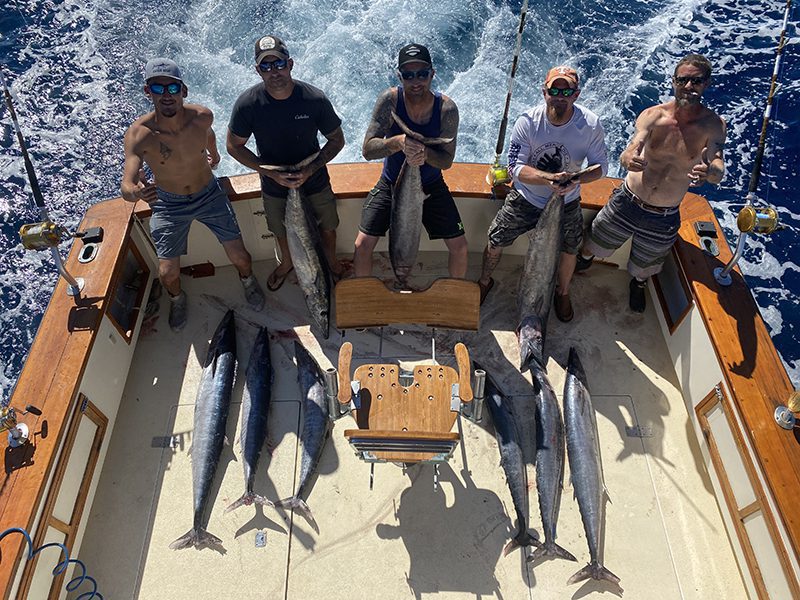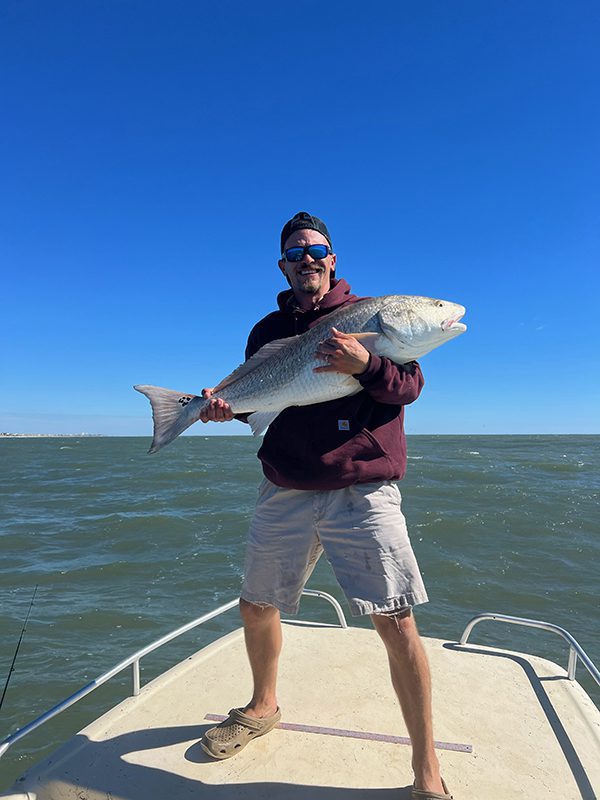Carolina Beach – November 2022
Andrew, of Island Tackle and Hardware, reports that surf anglers are still finding some smaller pompano around, with the bigger pompano (to citation-class) being caught in Snows Cut and the river.
Inshore anglers are hooking some nice sheepshead and black drum while targeting areas of structure.
Speckled trout fishing has been a bit hit or miss. This bite is just about to pop off, though, once some cold fronts start moving through and bring water temperatures down.
Surf fishing has seen catches of bluefish, as well as some citation-class drum, off Kure Pier.
Offshore anglers have been finding some good wahoo and mixed blackfins out at the break.

Brian Owens, Brent Connor, and Jessie McCarty (three in the middle) with some of the wahoo they caught while pulling Blue Water Candy skirted ballyhoo 60 miles out in 200+’ of water. They were fishing on the Wild Rover III with Capt. Dave Tilley and the crew from the Fish Whistle.
Christian, of Seahawk Inshore Fishing Charters, reports that anglers have been catching plenty of red drum, with some black drum mixed in.
The reds are feeding on live mullet and dead mullet or shrimp. Anglers are having to weed through some 12-16” fish to find the slots, but they are around. Fishing the falling tide cycle has been best up until the first hour or so of rising.
The black drum have preferred dead shrimp fished around shell drop-offs and grass edges. Both high and low tides have seen a decent bite for these (mostly) keeper fish.
Anglers are starting to see some speckled trout as well. They are hitting soft plastics or MirrOlures, and at times even feeding on a live mullet.
Luke, of Spot On Charters, reports that speckled trout fishing is getting really good in terms of both numbers and size. Topwater plugs have been the best first thing in the early mornings, when conditions are calm and cooler water have these trout pushed a bit shallower or up in the column.
A switch to sub-surface lures (such as MirrOlure MR-17s) is a great idea when the trout stop swirling the top as the sun gets a bit higher.
Throughout the rest of the day, a soft plastic on a heavier 3/8 oz. jig head will keep your bait down where these fish are holding. There has been pretty good water clarity in the river, and darker color patterns in all baits have seemed to be working best. The tides have also affected this bite, with higher tides being more productive on banks and lower tides requiring deeper waters (5-6’) with some current.
Red drum are scattered around in these same areas. Anglers look forward to the reds schooling up in larger schools moving into late fall/early winter.
Tommy, of Mungo Fishing Charters, reports that red drum action continues to be strong throughout the area. These reds are staged up around deeper holes with nearby oyster bars. On the calmer, clear days, anglers are able to sight cast at these schools with Big Nic jigs and Gulp shrimp. When the conditions aren’t ripe, a natural bait can generate success, with live shrimp, fresh dead shrimp, and cut baits all producing some strikes.
The black drum action has been good for anglers fishing dead shrimp, fiddler crabs, and mud crabs around deep hard structures such as docks, rocks, and oyster beds.
Anglers have been catching speckled trout. A wide assortment of hard and soft baits have garnered strikes when fished around moving water on deep banks or in creek mouths. These trout love deeper waters, so target areas with 5-7’ depth ranges.
Mason, of Grand Slam Fishing Charters, reports that redfish are beginning to school up on the flats during lower tides to search for bait. These fish will be hungry, and finding them should lead to strikes. Topwater plugs work great for targeting these shallow-holding schools. Soft plastics such as Gulp and Z-Man paddle tails on 1/4 oz. jig heads will also have success.
There are other groups of red drum staged up in the mainland creeks. Typically, these fish are holding along banks that have shell banks or oysters. Carolina-rigged shrimp, mud minnows, or mullet work great in this area.
Black drum are plentiful right now. Anglers are targeting these fish in deeper (4-8’) areas using live or dead shrimp on Carolina rigs. An oyster point in a creek with a good tidal flow is a great area to focus efforts. Docks and other rocky structures are also good areas to look for black drum.
The Cape Fear River will be a great place to trout fish from now through the end of the year. Target areas with good current flow using live shrimp, MirrOlures, or D.O.A. soft plastic shrimp. As waters cool down, these trout will also be found in deeper holes up towards the backs of creeks.

Dylan Bibb, of Carolina Beach, landed this 41.5″ red drum using live mullet in the Carolina Beach area.
Rod, of OnMyWay Fishing Charters, reports that spanish mackerel fishing is nothing short of great with the larger fall fish now in the area. Clarkspoons, sized up (#0 and #1) for these bigger fish under a planer has been doing the trick. Look for the schools to be anywhere from the inlets out on the beachfronts in 20-30’ of water.
It’s a good idea to also drag a ballyhoo with a stinger rig back in the spread for the chance at one of the kings pushed onto the beach.
Most king mackerel action is off in the 6-mile range, with action all the way out to 20 miles.
Bottom fishing is great in the 18-35 mile range. Anglers are catching grouper, big black sea bass, big vermilion snapper, and much more.
Running out to the break has been rewarded with some excellent wahoo action. These packs of fish (sometimes 1-2, other times 7-9 fish) are staged up around rockpiles in the 150-220’ area.
There are also some chunky blackfin tuna and sailfish mixed in the trolling bite, and a few late season mahi are being caught when finding an area of warmer waters.
Anthony, of Kure Beach Pier, reports that there remains a good spanish mackerel and bluefish bite for anglers casting plugs around bait moving by the pier.
With bottom fishing, anglers are catching pompano, croakers, spot, and some nice whiting. Red drum are also mixed in the action for those rigged with cut bait.





